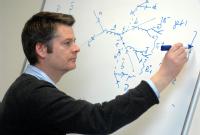Warwick research with T2K experiment could be step closer to solving the mystery of missing antimatter
 University of Warwick physicists have been involved in the definitive observation of muon neutrino to electron neutrino transformation – a process which could provide a clue to why the Universe has more matter than antimatter.
University of Warwick physicists have been involved in the definitive observation of muon neutrino to electron neutrino transformation – a process which could provide a clue to why the Universe has more matter than antimatter.
The announcement was made at the European Physical Society meeting in Stockholm by the international T2K collaboration which includes researchers from Warwick Experimental Particle Physics Group.
In 2011, the collaboration announced the first indication of this process, a new type of neutrino oscillation.
Now, with 3.5 times more data this transformation is firmly established. The probability that random statistical fluctuations alone would produce the observed excess of electron neutrinos is less than one in a trillion.
The T2K observation is the first to explicitly register the appearance of electron neutrinos from a beam of neutrinos consisting of muon neutrinos alone.
Dr Gary Barker from the University of Warwick’s Department of Physics said: “The Warwick group were involved with the design and construction of components of the T2K detector systems and have been contributing to the analysis of the data over the last three years which has culminated in this world-leading measurement.
“This result shows that we are able to measure a process i.e. muon- to electron-neutrino transitions, that is sensitive to whether neutrinos and anti-neutrinos behave in the same way.
“This has fundamental implications for our understanding of how a matter-antimatter imbalance could have originated in the early Universe.
“'This measurement paves the way to now go further with T2K, and future similar projects, to determine what role neutrinos play in the observed absence of anti-matter in the Universe.”
In the T2K experiment in Japan, a muon neutrino beam is produced in the Japan Proton Accelerator Research Complex, called J-PARC, located in Tokai village, Ibaraki prefecture, on the east coast of Japan.
The neutrino beam is monitored by a detector complex in Tokai and aimed at the gigantic Super-Kamiokande underground detector in Kamioka, near the west coast of Japan, 295 km (185 miles) away from Tokai.
An analysis of the data from the Super-Kamiokande detector associated with the neutrino beam time from J-PARC reveals that there are more electron neutrinos (a total of 28 events) than would be expected (4.6 events) without this new process.
Neutrino oscillation is a manifestation of a long range quantum mechanical interference. Observation of this new type of neutrino oscillation leads the way to new studies of charge-parity (CP) violation which provides a distinction in physical processes involving matter and antimatter. This phenomenon has only been observed in quarks (for which Nobel prizes were awarded in 1980 and 2008).
CP violation in neutrinos in the very early universe may be the reason that the observable universe today is dominated by matter and no significant antimatter, which is one of the most profound mysteries in science.
Now with T2K firmly establishing this form of neutrino oscillation that is sensitive to CP violation, the search for CP violation in neutrinos will become a major scientific quest in the coming years, and T2K will continue to play a leading role. The T2K experiment expects to collect 10 times more data in the near future, including data with antineutrino beam for studies of CP violation in neutrinos.
The T2K experiment was constructed and is operated by an international collaboration. The current T2K collaboration consists of over 400 physicists from 59 institutions in 11 countries [Canada, France, Germany, Italy, Japan, Poland, Russia, Switzerland, Spain, UK and US]. The experiment is primarily supported by the Japanese Ministry of Education, Culture, Sports, Science and Technology (MEXT).
Additional support is provided by the following funding agencies from participating countries: NSERC, NRC and CFI, Canada; CEA and CNRS/IN2P3, France; DFG, Germany; INFN, Italy; Ministry of
Science and Higher Education, Poland; RAS, RFBR and the Ministry of Education and Science of the Russian Federation; MICINN and CPAN, Spain; SNSF and SER, Switzerland; STFC, U.K.; DOE, U.S.A.
This discovery was made possible with the unyielding and tireless effort by the J-PARC staff members and the management to deliver high quality beam to T2K after the devastating March 2011 earthquake in eastern Japan which caused severe damage to the accelerator complex at J-PARC, and abruptly discontinued the data-taking run of the T2K experiment.
ENDS
To speak to a Warwick academic please contact Anna Blackaby on 02476 575910 or 07785 433155 or a dot blackaby at warwick dot ac dot uk
More detailed information on this announcement including images, T2K experiment and T2K collaboration can be found from the T2K public webpage: http://t2k-experiment.org 
To speak to a Warwick academic please contact Anna Blackaby on 02476 575910 or 07785 433155 or a dot blackaby at warwick dot ac dot uk
More detailed information on this announcement including images, T2K experiment and T2K collaboration can be found from the T2K public webpage: http://t2k-experiment.org
